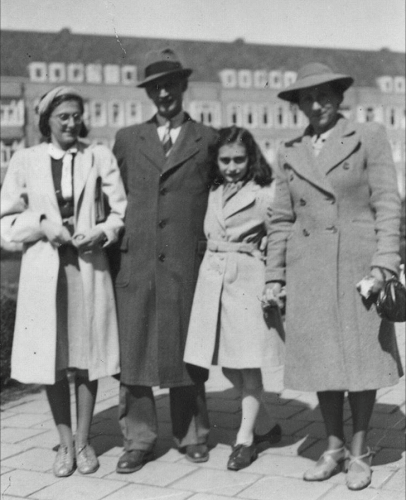From the Diary of Anne Frank Summary class 10 EnglishIntroductionThe heart-touching book "Anne Frank: The Diary of a Young Girl" offers a distinctive viewpoint on the Holocaust through the eyes of a young child. The book details Anne and her family's adventures as they hide to avoid persecution during World War II and is made up of entries from Anne Frank's personal diary. The journal offers not only a first-person account of the horrors committed against Jews during the war but also a window into Anne's private thoughts, feelings, and experiences as she faces adolescence's difficulties while in hiding. The book has received a lot of attention and praise for its candour, sincerity, and reminder of the human cost of prejudice and hatred. In order to comprehend "Anne Frank: The Diary of a Young Girl" more fully, we shall examine the numerous themes, characters, and events in greater detail in this article. 
SummaryThe reader is given an overview of Anne's life before going into hiding in the opening chapter of the book. She was an outgoing girl who enjoyed talking and reading. She discusses her friends, family, and school-related experiences. She also talks about the rising unrest in Europe and the prejudice she saw against Jews in her neighbourhood. 
On July 6, 1942, the day the Frank family went into hiding, the second chapter starts. They shared a hidden annex above Mr. Frank's office with the Van Daans family and, afterward, Mr. Dussel, a dentist. Anne discusses the hardships of living in a confined place with so many people, as well as the difficulty of concealing and the persistent worry of being found out. Anne describes her day-to-day activities at the annexe in chapter three. She tells of the habits and customs she and the others developed, as well as their efforts to amuse and occupy themselves. She also talks about the challenges of residing with the contentious and obnoxious Van Daans. One of the most well-known sections of the book is Chapter 4, which describes Anne's sentiments about her changing body as she enters puberty. She is both delighted and humiliated by the possibility of growing up as well as by her first period and changing body form. Anne talks about how she has come to comprehend the conflict and the crimes being performed against Jews in chapter five. She discusses her worries for her family and the wider world, as well as her mounting rage and irritation over how unfair everything is. The news of the invasion of Normandy on June 6, 1944, signals the start of chapter six. Anne believes that this will signal the end of the conflict and lead to their eventual exile. She tells about the party that is held in the annexe and how excited she is at the idea of a fresh start. The book changes direction in chapter seven as Anne's entries become more reflective and meditative. She starts to reflect more intently on who she is and what her life's purpose is. As a result of her perception that her family and the other residents of the annexe do not fully comprehend her, she also begins to remove herself from them. Anne considers her connection with her father and the ways in which he has let her down in chapter eight. She also discusses how she is becoming more and more in love with Peter Van Daan, the son of the other family sheltering beside them. The book's conclusion is hinted at in chapter nine when Anne's writings grow increasingly erratic and disjointed. She writes of the annexe's growing tension and her worry that they'll be found at any second. The day the Gestapo raids the annex and the residents are detained is described by Anne in the concluding chapter. She tells of her final minutes in the annexe and her hope to soon be with her loved ones. Sadly, Anne and the majority of the other members of the annexe perished in concentration camps in the future. The book "Anne Frank: The Diary of a Young Girl" offers an original and intimate viewpoint on one of the darkest eras in human history. The writings in Anne's journal are frank, sincere, and frequently thought-provoking; they provide a window into the thoughts of a little girl trying to make sense of a crazy world. The book serves as both a lesson to never forget the crimes of the past and a monument to the tenacity of the human spirit. Important Questions & AnswersQ1. What is "Anne Frank: The Diary of a Young Girl" about?Answer: "Anne Frank: The Diary of a Young Girl" is a book composed of entries from Anne Frank's diary, providing a first-hand account of the Holocaust from the perspective of a young Jewish girl who went into hiding with her family in Amsterdam during World War II. Q2. What is the significance of Anne's diary?Answer: Anne's diary is significant as it offers a unique and personal perspective on the Holocaust, providing insight into the mind of a young girl struggling to make sense of a world gone mad. It is also a powerful reminder of the atrocities committed against Jews during World War II. Q3. What is the setting of the book?Answer: The book is set in Amsterdam, Netherlands, during World War II, specifically in a secret annex above Mr. Frank's office where the Frank family and another family, the Van Daans, went into hiding. Q4. How did Anne feel about her changing body in chapter four?Answer: In chapter four, Anne writes about her changing body and her struggle to come to terms with the physical changes she is experiencing. She feels self-conscious about her developing body and worries that she is not as attractive as other girls her age. Anne's feelings about her changing body are complicated by the fact that she is in hiding and cannot go outside or engage in physical activity like she used to. She writes about feeling restless and bored and missing the freedom of being able to run and play outside. Despite these challenges, Anne also shows moments of self-acceptance and self-love. She writes about the importance of accepting oneself for who they are and not worrying about what others think or say. Anne's struggles with body image and self-esteem are relatable to many readers and serve as a reminder of the challenges faced by young people as they navigate the complexities of adolescence. Q5. What is the significance of chapter seven?Answer: Chapter seven marks a turning point in the book, as Anne's entries become more introspective and contemplative. She begins to think more deeply about her own identity and the meaning of her life and starts to distance herself from her family and the others in the annexe. Q6. How does the book end?Answer: The book ends with the raid of the annexe by the Gestapo and the arrest of the inhabitants. Anne writes about her last moments in the annexe and her belief that she will be reunited with her loved ones soon. Unfortunately, Anne and most of the others in the annexe were later killed in concentration camps. Q7. What is the message of the book?Answer: The message of "Anne Frank: The Diary of a Young Girl" is multifaceted, but one of the most significant themes is the importance of hope and perseverance in the face of adversity. Through Anne's diary entries, readers are able to gain insight into the struggles and challenges faced by Jews during the Holocaust and witness first-hand the power of the human spirit to endure even the darkest of times. The book also serves as a reminder of the devastating consequences of hatred and discrimination. Anne's diary provides a first-hand account of the atrocities committed against Jews during the war and highlights the devastating impact of bigotry and intolerance on individuals and communities. At its core, "Anne Frank: The Diary of a Young Girl" is a tribute to the resilience and strength of the human spirit. Despite the unimaginable challenges faced by Anne and her family, they never lose hope or their belief in the goodness of humanity. Anne's diary is a testament to the power of hope, resilience, and the human spirit to overcome even the direst of circumstances. Q8. Who is Peter Van Daan, and what is Anne's relationship with him?Answer: Peter Van Daan is one of the occupants of the secret annexe, where Anne and her family go into hiding during the war. He is the son of the other family in hiding with the Franks and is around the same age as Anne. Initially, Anne has little interest in Peter and finds him to be shy and boring. However, as time goes on, they develop a close friendship and spend more time together. Anne helps to bring Peter out of his shell, and they bond over their shared experiences and struggles in hiding. As the diary progresses, Anne's relationship with Peter becomes more romantic. They share their first kiss on New Year's Eve, and their relationship continues to grow in the subsequent months. However, their relationship is not without its challenges, as Anne struggles with jealousy and doubts about Peter's feelings for her. Despite these challenges, Anne and Peter's relationship is a testament to the power of human connection in even the darkest of times. Their love serves as a reminder of the importance of hope and companionship in the face of adversity. Q9. How does Anne's view of the war and the world change over time?Answer: Anne's view of the war and the world undergoes a significant transformation over the course of the diary. At the beginning of the diary, Anne is optimistic and hopeful that the war will end soon and that life will return to normal. However, as time goes on and the family's situation becomes more precarious, Anne's view becomes more pessimistic. As Anne begins to witness the horrors of the war and the persecution of Jews, she becomes increasingly disillusioned with the world around her. She writes about the unfairness and cruelty of life and her belief that humanity is fundamentally flawed. She also struggles with feelings of loneliness and isolation and becomes more introspective and contemplative in her writing. Despite her struggles, however, Anne never loses her innate sense of optimism and hope. She continues to believe in the power of goodness and kindness, and her unwavering spirit is a testament to the resilience of the human spirit in the face of adversity. Overall, Anne's view of the war and the world changes from one of optimism to one of pessimism, but her unwavering spirit and belief in the power of goodness serve as a reminder of the importance of hope in even the darkest of times. |
 For Videos Join Our Youtube Channel: Join Now
For Videos Join Our Youtube Channel: Join Now
Feedback
- Send your Feedback to [email protected]
Help Others, Please Share









